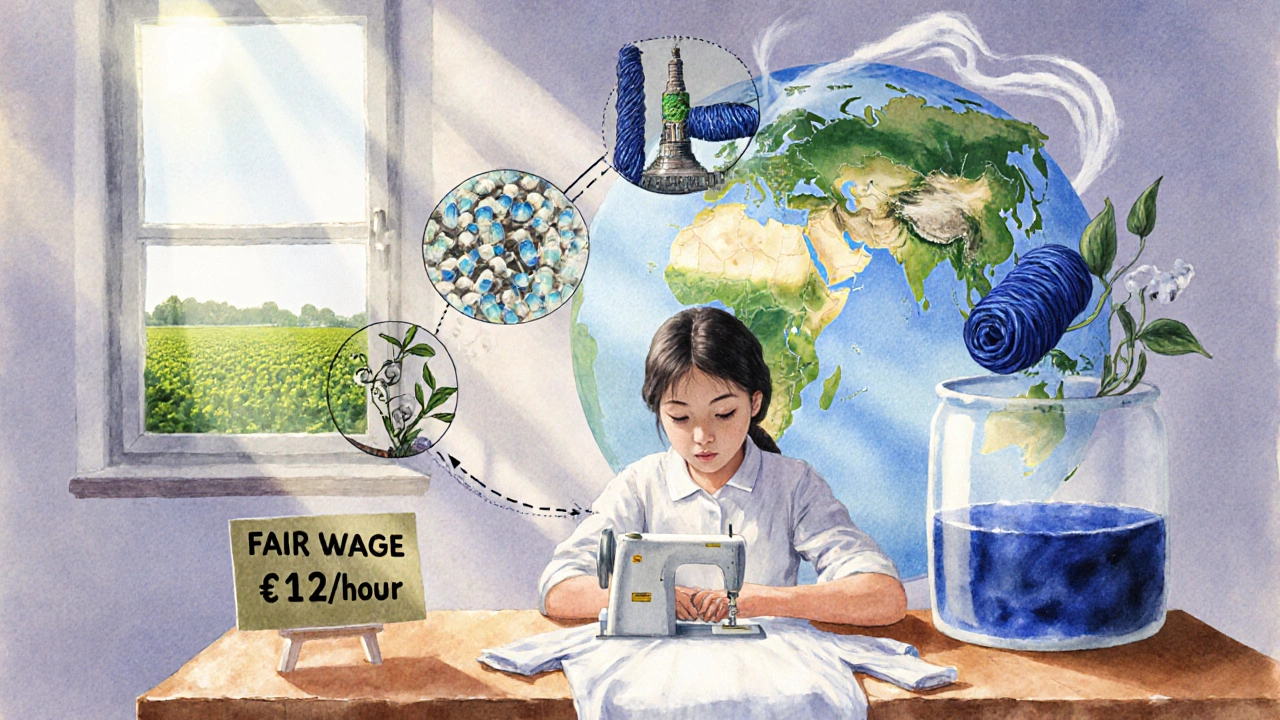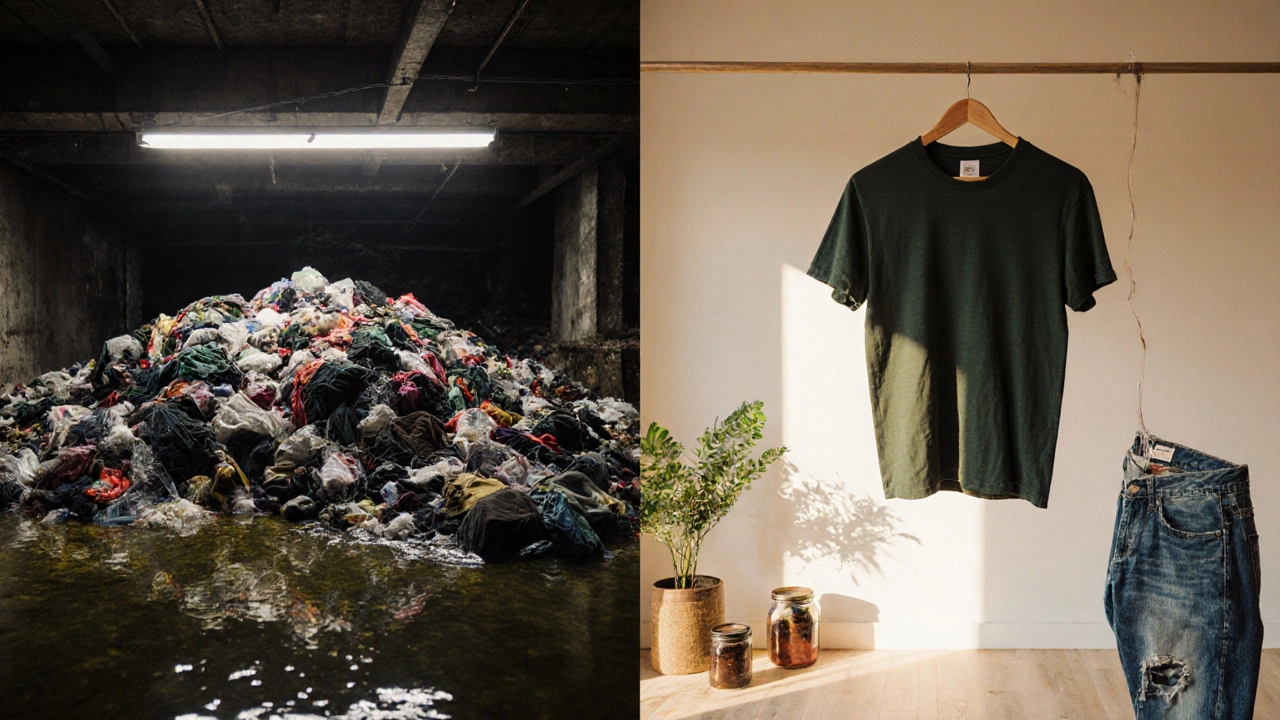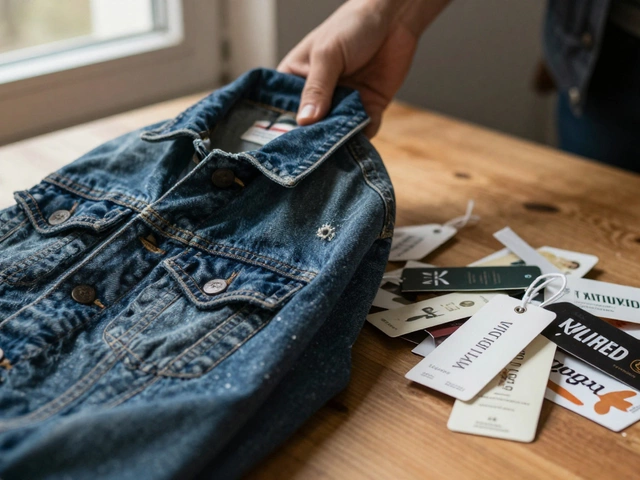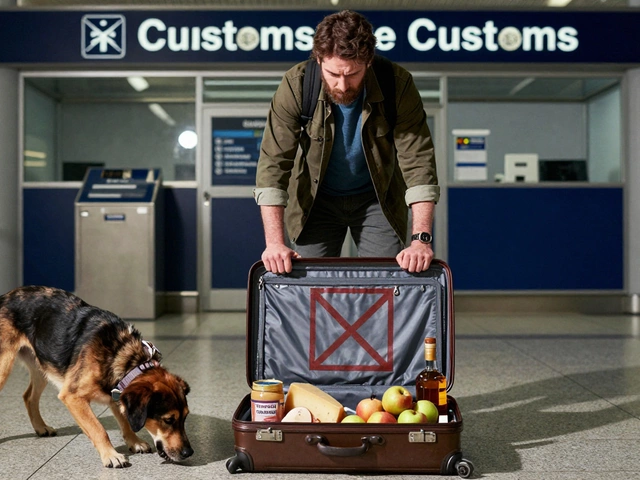Sustainable Fashion Cost Calculator
How Sustainable Fashion Pays Off
See how sustainable clothing becomes more cost-effective than fast fashion over time. Enter your values below to calculate the true cost per wear.
Fast Fashion Options
Sustainable Options
Cost Comparison
Fast Fashion
Cost per wear
Sustainable
Cost per wear
Key Insight: Sustainable fashion often costs 0% less per wear over time. For example, a $150 sustainable jacket lasting 10 years with 50 wears per year costs $0.30 per wear versus $3.00 for a $30 fast fashion jacket lasting 1 year.
Note: These calculations factor in the true costs of ethical production, durability, and environmental impact discussed in the article.
Ever looked at a $200 organic cotton t-shirt and wondered why it costs more than three fast fashion ones? You’re not alone. The price tag on sustainable fashion feels like a punch in the gut-especially when you’ve grown up buying $10 shirts that last one season. But here’s the truth: that $10 shirt wasn’t cheap. Someone paid for it. Just not at the register.
What You’re Really Paying For in Fast Fashion
Fast fashion works because it hides costs. Those $8 jeans? They’re made in a factory where workers earn less than $2 a day. The dye? Toxic chemicals dumped into rivers. The fabric? Polyester, made from oil, taking 200 years to break down. The shipping? Containers crisscrossing the globe, burning fossil fuels. All of it gets buried under marketing slogans like "new arrivals every week" and "limited stock!"
When you buy a $12 hoodie from a big brand, you’re not paying for the real cost of making it. You’re paying for the illusion of affordability. The real cost is carried by workers in Bangladesh, farmers in Uzbekistan forced to grow cotton with pesticides, and the planet itself. That’s why sustainable fashion feels expensive-it’s finally showing you the bill.
Materials That Don’t Hurt the Earth
Sustainable brands don’t use regular cotton. They use organic cotton, which is grown without synthetic pesticides or GMO seeds. Organic cotton uses 91% less water than conventional cotton, according to the Textile Exchange. But that cleaner farming means lower yields. Less cotton per acre = higher price per kilo.
Then there’s TENCEL™, made from sustainably harvested wood pulp. Or recycled polyester, which turns plastic bottles into fabric. These materials cost more because they require specialized processing. Recycled polyester needs sorting, cleaning, and re-spinning-something factories that churn out virgin polyester don’t bother with. It’s slower. It’s harder. It’s more expensive.
And don’t forget natural dyes. Conventional dyes use toxic chemicals like azo dyes that pollute waterways. Sustainable brands use plant-based dyes-indigo from leaves, madder root for red, turmeric for yellow. These dyes fade slower, but they’re harder to source in bulk. One ton of natural dye might cost 5x more than synthetic dye. That adds up.
Small Batches, Not Mass Production
Fast fashion thrives on volume. One factory makes 50,000 identical shirts in a week. That’s how they get the price down. Sustainable brands make 200 to 500 pieces per style. Why? Because they don’t want to overproduce. They don’t want to end up with unsold stock that gets burned or dumped in landfills.
Small batches mean no economies of scale. Cutting fabric, sewing seams, stitching labels-each step takes time and labor. A factory making 50,000 shirts can automate most of it. A small workshop making 300? Every shirt is handled by hand, often by skilled tailors who earn living wages.
In Bangladesh, a garment worker might earn $3 a day making fast fashion. In Portugal, where many sustainable brands produce, a seamstress earns €12 an hour-plus health insurance and paid leave. That’s not a luxury. It’s a baseline. And it shows up in the price tag.

Transparency Isn’t Free
Sustainable brands don’t hide their factories. They name them. They show photos. They let you see the people who made your clothes. That level of transparency takes work. It means audits. It means certifications. It means paying for third-party verifiers like GOTS (Global Organic Textile Standard) or Fair Trade Certified.
Getting GOTS certified costs thousands of dollars upfront. Then there’s the annual fee. A small brand might spend $5,000 to $15,000 a year just to prove they’re not lying. Fast fashion brands skip this. They don’t need to. No one’s asking.
And then there’s traceability. Some brands use blockchain to track cotton from farm to garment. Others partner with farmers directly, paying premiums to ensure regenerative practices. These systems aren’t plug-and-play. They’re built from scratch. And they cost money.
Design That Lasts
Fast fashion is designed to fall apart. Zippers break after three washes. Seams unravel. Colors bleed. It’s intentional. The goal is to make you buy again next season.
Sustainable fashion is designed to last. That means double-stitched seams. Reinforced stress points. Higher thread counts. Solid brass zippers instead of cheap plastic. Buttons sewn on with industrial machines, not flimsy hand-stitching. One brand in Sydney tested their jackets for 100 washes. The fast fashion equivalent? Fell apart at 12.
That durability isn’t magic. It’s material choice, construction, and quality control. And it costs more to get right. But here’s the math: if you buy one $180 jacket that lasts 10 years, you’re paying $18 a year. A $30 jacket that lasts one year? That’s $30 a year. Suddenly, the "expensive" one is the cheaper option.

Why the Price Gap Feels So Big
The real reason sustainable fashion feels expensive? Because fast fashion has trained us to expect clothes to be dirt cheap. We’ve forgotten what clothing should cost. For most of human history, clothes were made by hand, passed down, repaired. They were valuable. Then mass production happened. Prices collapsed. And we stopped valuing the people who made them.
Sustainable fashion is trying to reset that expectation. It’s not trying to be expensive. It’s trying to be honest. The $200 sweater isn’t overpriced-it’s priced to reflect the true cost of making something good, ethical, and lasting.
What You Can Do Right Now
You don’t need to buy everything new. Start by asking: Do I really need this? Can I rent it? Can I borrow it? Can I fix what I already own?
Thrift stores are full of high-quality pieces from brands like Patagonia, Eileen Fisher, and even Levi’s. Repairing a torn seam or replacing a button costs less than $10 and extends the life of your clothes by years.
When you do buy new, look for these three things: organic or recycled materials, transparent supply chains, and brands that offer repair services. You’re not just buying a shirt. You’re voting for a system that values people and the planet.
And if you’re still worried about the price? Think in years, not dollars. A $150 coat that lasts 8 years costs less per wear than a $50 coat you replace every season. That’s not luxury. That’s smart.
Is sustainable fashion really better for the environment?
Yes-when you compare the full lifecycle. Organic cotton uses 91% less water than conventional cotton. Recycled polyester keeps plastic out of oceans. Natural dyes don’t poison rivers. And because sustainable clothes last longer, fewer end up in landfills. Fast fashion produces 10% of global carbon emissions-more than international flights and shipping combined. Sustainable brands cut that impact by design.
Why don’t big brands just go sustainable?
Because their business model depends on speed and low cost. Switching to organic materials, fair wages, and small batches would shrink their profit margins. They’d have to stop making 50 new styles a week. They’d have to stop burning unsold stock. They’d have to admit their current system is broken. That’s not a pivot-it’s a revolution. And most big brands aren’t ready to lead one.
Are there affordable sustainable brands?
Yes-but they’re not $10 tees. Brands like Pact, Thought Clothing, and Amour Vert offer basics under $50. They use organic cotton, pay fair wages, and ship carbon-neutral. They’re not cheap, but they’re far more affordable than luxury sustainable labels. The key is to buy less, buy better, and look for sales or secondhand options.
Does buying secondhand count as sustainable fashion?
Absolutely. Buying used clothes is the most sustainable choice you can make. It skips production entirely-no water, no dyes, no shipping. A thrifted denim jacket saves about 2,000 liters of water compared to buying new. And you’re giving clothes a second life. Thrifting isn’t a compromise-it’s the gold standard of sustainable fashion.
What’s the most expensive part of making sustainable clothes?
Labor. Fair wages, safe conditions, and benefits for workers make up the biggest cost. Materials come second. A $150 sweater might cost $30 in fabric and $80 in labor. In fast fashion, labor is often under $2. The price difference isn’t about luxury-it’s about justice.
Final Thought: Paying for the Truth
Sustainable fashion isn’t expensive because it’s fancy. It’s expensive because it’s honest. It doesn’t pretend the planet has infinite resources or that people don’t matter. It says: this shirt cost more because it was made right. And if you’re tired of paying the hidden price of fast fashion, then the real question isn’t why it costs so much. It’s: why did we ever accept so little?










